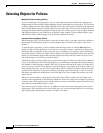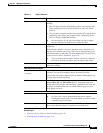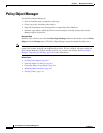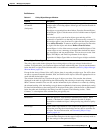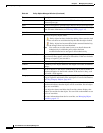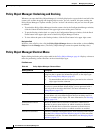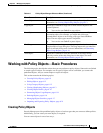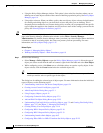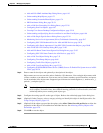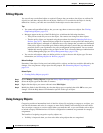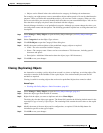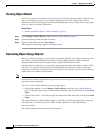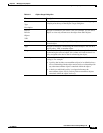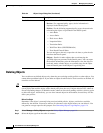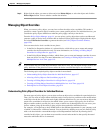
6-10
User Guide for Cisco Security Manager 4.4
OL-28826-01
Chapter 6 Managing Policy Objects
Working with Policy Objects—Basic Procedures
• Using the Policy Object Manager window. This option is best suited for situations where you are
defining one or more objects outside of the context of defining a particular policy. See Policy Object
Manager, page 6-4.
• Using object selectors. When you define a policy that uses objects, object selectors include buttons
for creating and editing objects so you don’t have to leave the policy you are defining. This is
frequently the best method to use, because during policy creation you are prompted for the specific
type of object that applies to the situation, and you are more aware of the settings you need for the
policy. See Selecting Objects for Policies, page 6-2.
Tip Your ability to create multiple objects with the same definition depends on a setting on the Policy Objects
page in the Security Manager Administration window (select Tools > Security Manager
Administration). By default, Security Manager warns you when you create an object whose definition
is identical to that of an existing object, but it does not prevent you from proceeding. For more
information, see Policy Objects Page, page 11-47.
Related Topics
• Chapter 6, “Managing Policy Objects”
• Working with Policy Objects—Basic Procedures, page 6-9
Step 1 Do one of the following:
• Select Manage > Policy Objects to open the Policy Object Manager, page 6-4. Select the type of
object you want to create from the table of contents, right-click in the table and select New Object.
• While configuring a rule, click Select next to a field that allows or requires a policy object. In the
object selector, click the Create button below the available objects list.
Tip In a few cases, such as network/host and service objects, clicking these buttons opens a list from
which you need to select a specific type for the object.
The dialog box for adding the selected type of object opens. For more information about the individual
types of objects, see the following topics:
• Understanding AAA Server and Server Group Objects, page 6-24
• Creating Access Control List Objects, page 6-49
• ASA Group Policies Dialog Box, page 33-1
• Using Category Objects, page 6-12
• Configuring Credentials Policy Objects, page 27-9
• Add and Edit File Object Dialog Boxes, page 33-25
• Understanding FlexConfig Policies and Policy Objects, page 7-2 and Creating FlexConfig Policy
Objects, page 7-27 (in Chapter 7, “Managing FlexConfigs”)
• Creating Identity User Group Objects, page 13-19
• Configuring IKEv1 Proposal Policy Objects, page 25-10
• Configuring IKEv2 Proposal Policy Objects, page 25-13
• Understanding Interface Role Objects, page 6-67
• Configuring IPSec IKEv1 or IKEv2 Transform Set Policy Objects, page 25-25



